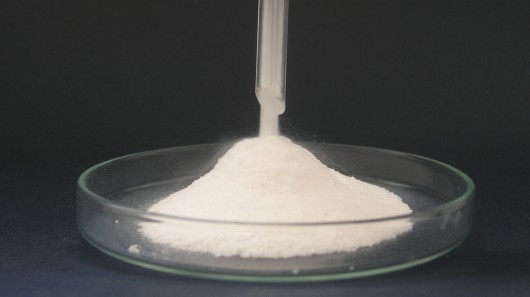
You know, Iím pretty sure I remember a Far Side cartoon or something, where someone was selling powdered water Ė ďJust add water!Ē Well, dry water isnít quite the same thing. Itís 95 percent liquid water, but that water takes the form of tiny droplets each encased in a tiny globe of silica. The resultant substance is dry and granular. It first came to light in 1968, and was used in cosmetics. More recently, a University of Liverpool research team has been looking into other potential uses for the substance. They have found several, but most interesting is its ability to store gases such as carbon dioxide.
In laboratory experiments, study leader Professor Andrew Cooper and his team found that dry water absorbed over three times as much CO2 as uncombined water and silica in the same amount of time. The gas combined with the water molecules to form a storable hydrate, which Cooper believes makes it ideal for reducing global warming.
The Liverpool team also found that dry water could be used to store methane gas. As methane is a component of natural gas, they believe this discovery could make natural gas a more environmentally-viable energy source. They suggest that dry water could be used to absorb and transport the methane from stranded deposits of natural gas, or as a storage medium for methane fuel for cars.
Another use that was discovered for dry water is as a catalyst to speed up reactions between hydrogen gas and maleic acid to produce succinic acid, a feedstock or raw material widely used to make drugs, food ingredients, and other consumer products. Hydrogen gas and maleic acid traditionally have to be stirred together to create a reaction, so by eliminating the need for mechanized stirring, maleic acid-infused dry water would allow for a more energy-efficient production process of the products.
In yet another possible application, potentially harmful liquid emulsions could be transformed dry water-style into a dry powder, making them safer to store and transport.
The team is now seeking commercial or academic collaborators to further develop the technology. "There's nothing else quite like it," said researcher Ben Carter. "Hopefully, we may see 'dry water' making waves in the future."
The research was reported this Wednesday at the 240th National Meeting of the American Chemical Society.
Copyright © gizmag 2003 - 2010 To subscribe or visit go to: http://www.gizmag.com